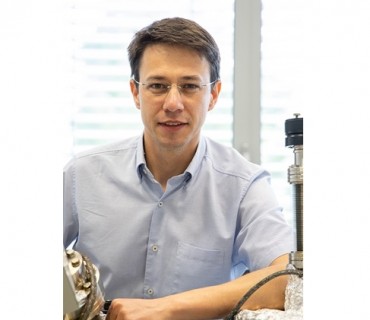Biography
Slovenian Chemical Society, Ceramics Section, Chairman, 2018-present
European Ceramic Society, Council Member, 2018-present
International Ceramic Federation, Council Member, 2018-present
American Ceramic Society, Electronic Division, Nomination Committee member, 2017-present
Professional Career
2024/3-present: Research Counsellor, Advanced Materials Department, Jožef Stefan Institute
2018/4-present: Head, Advanced Materials Department, Jožef Stefan Institute
2018/1-2024/3: Senior research associate, Advanced Materials Department, Jožef Stefan Institute
2017/8-2018/3: Assistant head, Advanced Materials Department, Jožef Stefan Institute
2016/10-present: Assistant Professor of Materials Science and Engineering at University of Ljubljana, Faculty of Chemistry and Chemical Technology
2012/12-present: PLD laboratory manager
2012/12-2018/1: Research associate, Advanced Materials Department, Jožef Stefan Institute
2008/3-2012/12: Postdoctoral researcher, Advanced Materials Department, Jožef Stefan Institute
2010/4-2011/4: Postdoctoral researcher, Inorganic Materials Science Group, group of prof. Guus Rijnders, Faculty of Science & Technology, University of Twente, The Netherlands
-Project coordination: Slovenian Research Agency (Research programme P2-0091, Research projects J2-9237and J2-6759), M-ERA.NET (projects SIOX and ENPIEZO), Industrial projects with Urban Mining Company, USA and EPCOS OHG, Austria.
-Member of Jožef Stefan Institute Investment Committee (2017-2021): Review of JSI investment strategy, investment analysis and monitoring.
-Slovenian Smart Specialization Strategy (S4): Preparation of strategic documents, related to Advanced Manufacturing Systems and New Materials within in the Factories of the Future domain.
-Organization of scientific meetings: In 2016 I was a conference chair of COST TO-BE Fall meeting (TO-BE: Towards Oxide-Based Electronics). The meeting, which was held in Ljubljana, Slovenia, had more than 110 participants, mainly from Europe, and represented an important form for researchers working in the field of the science and technology of transition-metal oxides.
-Reviewer of research articles: Chemistry of Materials, Journal of the European Ceramic Society, Journal of the American Ceramic Society, Journal of Alloys and Compounds, Applied Physics Letters, Thin Solid Films, Materials Research Bulletin, etc.
-Teaching activities: In 2016 I was elected for an Assistant professor position for Materials Science and Engineering at Faculty of Chemistry and Chemical Technology, University of Ljubljana, Slovenia. Since 2017 I teach Materials Chemistry and Fundamentals of Materials Chemistry at Jožef Stefan International Postgraduate School, within Nanoscience and Nanotechnology Programme.
(Co)Supervisor of following students:
- Supervisor: Lea Udovč, PhD defence planned in 2021,
- Supervisor: Tjaša Parkelj, PhD defence planned in 2019,
- Supervisor: Urška Gabor, PhD defence planned in 2018,
- Supervisor: Dejan Klement, PhD defence in 2015,
- Cosupervisor: Sonja Jovanović, PhD defence in 2014,
- Cosupervisor: Tina Šetinc, PhD defence in 2013.
Graduation Committee Member of following PhD students:
- David Dubbink, University of Twente, 2017,
- Dejan Klement, Jožef Stefan International Postgraduate School, 2015,
- Sonja Jovanović, Jožef Stefan International Postgraduate School, 2014,
- Tina Šetinc, Jožef Stefan International Postgraduate School, 2013.
Education
2003/8: Bachelor of Chemical Engineering, Faculty of Chemistry and Chemical Technology, University of Ljubljana, Slovenia
2008/3: Doctor of Chemical Technology, Faculty of Chemistry and Chemical Technology, University of Ljubljana, Slovenia and Advanced Materials Department, Jožef Stefan Institute, Slovenia
Doctoral Thesis: “Influence of synthesis and structural characteristics on electrical properties of Na0.5Bi0.5TiO3-based voltage-tunable materials”
Research interests
- Silicon-oxide integration
For silicon-oxide interfaces we determined a new PLD-based pathway for components integration. For the first time we experimentally demonstrated a sub-monolayer control of Sr coverage using PLD and successful preparation of a reconstructed Si surface passivated with 1/2ML of Sr. Alternatively, we managed to reconstruct silicon also using SrO, which is chemically more stable compared to metallic Sr and thus outlines the importance of our achievement. For preparation of the STO layer on passivated Si we determined a complete protocol for epitaxial integration, taking into account the peculiarities of the PLD process. We observed that parameters for deposition and oxidation periods play a crucial role on the quality of the STO layer and the interface and have to be separated in time, while the reaction between STO and Si has to be kinetically trapped to minimize the thickness of the interface layer. These results present a milestone in the silicon-oxide integration and open a new technological route for oxide electronics, which demonstrate rich functionalities beyond the state-of-the-art silicon platform. Results have been published in several high-ranking journals (J. Mater. Chem. C, ACS Appl. Mater. Interfaces, Appl. Phys. Lett., etc.).
In the field of dielectric materials we focused on research of ceramics for voltage-tunable microwave applications. For Ag(NbxTa1-x)O3 system we determined solid-state reaction mechanism and protocol for preparation of single-phase ceramics. We also described the relation between voltage tunability and material`s polar order, which normally combines ferroelectric and antiferroelectric response. These results enabled us to complete Ag(NbxTa1-x)O3 phase diagram. For similar applications we also investigated Na0.5Bi0.5TiO3–SrTiO3 system, especially high-temperature reactions and the effect of oxygen overpressure on matrix`s stoichiometry. Cubic symmetry of these relaxor-like materials was explained in details using high-resolution XRD studies. For Na0.5Bi0.5TiO3–SrTiO3 system we also formed layered heterostructures with temperature stable dielectric characteristics.
Part of my research was also directed on the hydrothermal and solvothermal synthesis of cobalt ferrite nanoparticles (CFO), which were further integrated with piezoelectric materials into magnetoelectric composites. We investigated the effect of oleic acid concentration on the physicochemical properties of derived nanoparticles. Conditions for preparation of well-dispersed, non-agglomerated spherical particles of about 6 nm were determined, as a result of bridging bidentate interactions between the oleic acid molecules and the metal atoms on the surface of the nanoparticles. We also observed that these interactions affect the surface strain of nanoparticles considerably, as well as their magnetic properties, which become superparamagnetic at a critical concentration with decreased surface anisotropy. In addition to CFO we also investigated formation of SrTiO3 single-crystalline nanoparticles in relation to their structural defects.

